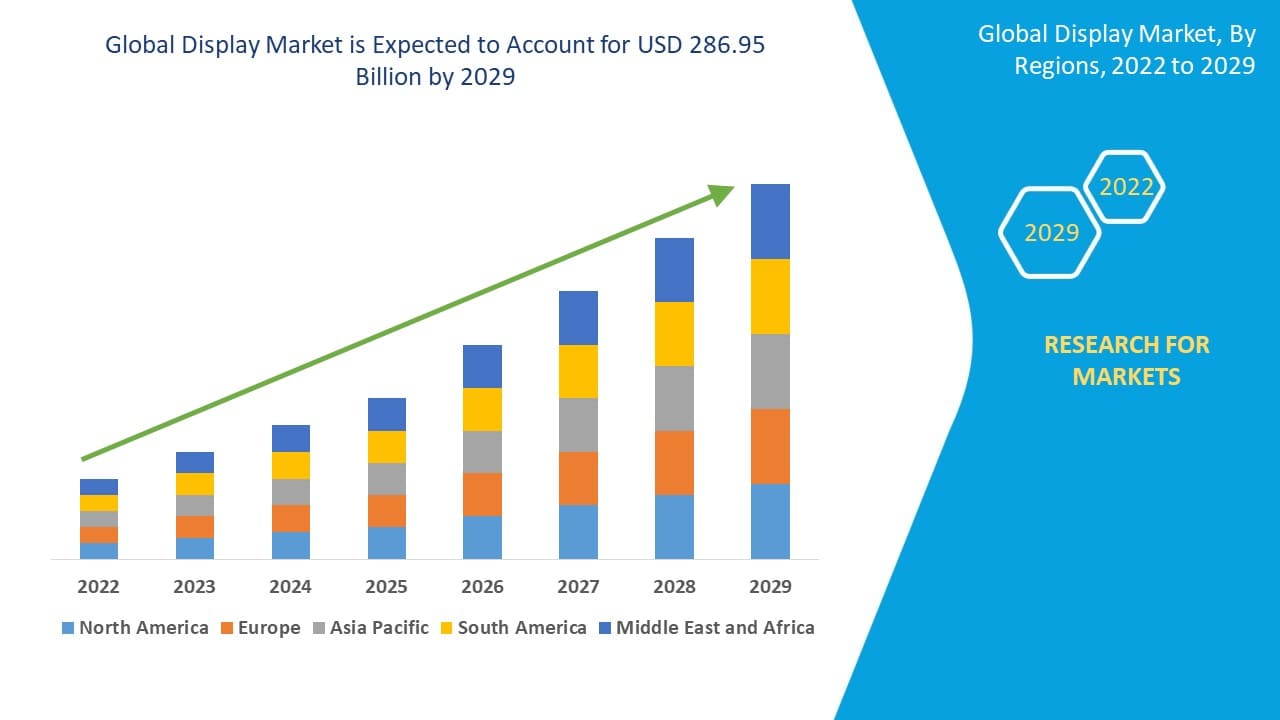Introduction to Global Display Market
- A display typically consists of a screen, a computer output surface, and a projection surface that shows text, graphic pictures, or other data using a cathode ray tube, light-emitting diode, liquid crystal display, or other technologies. It can be used in television, cell phones, tablets, laptops, cars, public transportation, and a variety of other industries.
- Displays are utilized in numerous sectors, including consumer electronics, automotive, healthcare, retail, gaming, education, and industrial applications. The consumer electronics segment, driven by smartphones, tablets, and televisions, holds
- The global display market is a thriving and rapidly evolving industry that encompasses a wide range of technologies and applications. From smartphones and televisions to automotive displays and digital signage, displays play a crucial role in our daily lives, enabling us to consume information, communicate, and interact with technology in various ways.
Global Display Market Analytics
- Numerous displays are now widely employed in a variety of industries, including entertainment, corporate, transportation, retail, hospitality, education, and healthcare, among others. These enable organizations to reach a larger audience. They also aid in the establishment of a centralized network for digital communications.
- Because of its widespread use in display products over the previous few decades, LCD has the largest technology segment in the respective industry. The market report curated by the Data Bridge Market Research team includes in-depth expert analysis, import/export analysis, pricing analysis, production consumption analysis, and pestle analysis, in addition to market insights such as market value, growth rate, market segments, geographical coverage, market players, and market scenario.
- According to Databridge market research, the Globa Display Market was valued at USD 150.40 billion in 2021 and will reach USD 286.95 billion by 2029, registering a CAGR of 8.41% during the forecast period of 2022-2029.
- For more insights on the global Display market visit https://www.databridgemarketresearch.com/reports/global-display-market
Emerging Technologies in the Global Display Market
The global display market is constantly evolving, with emerging technologies pushing the boundaries of visual experiences.
- OLED (Organic Light-Emitting Diode):
OLED technology is gaining momentum and revolutionizing the display market. OLED displays consist of organic compounds emitting light when electric current applies. This technology offers several advantages, including high contrast ratio, wide color gamut, fast response time, and flexibility. OLED displays can be found in smartphones, televisions, wearables, and even automotive applications.
- MicroLED (Micro-Light Emitting Diode):
MicroLED is a promising display technology that offers exceptional brightness, contrast, and energy efficiency. It consists of an array of tiny, self-emitting LEDs that are much smaller than traditional LEDs. MicroLED displays provide high resolution, wide color gamut, and superior picture quality. They develop for applications such as large-scale displays, TVs, augmented reality (AR) glasses, and smartwatches.
- Mini-LED:
Mini-LED technology is an intermediary between traditional LCD and emerging MicroLED displays. It uses a large number of small-sized LEDs as backlighting to enhance contrast, color accuracy, and HDR capabilities. Mini-LED displays offer improved local dimming zones, resulting in deeper blacks and better overall image quality. This technology is employed in high-end televisions and professional monitors.
4. Quantum Dot (QD) Displays:
Quantum dot displays utilize semiconductor nanocrystals called quantum dots to enhance color reproduction. Its dots emit precise colors when stimulated by a light source, resulting in a wider color gamut and improved color accuracy. This technology is commonly found in QLED (Quantum dot LED) displays, which are popular in high-end televisions.
- Transparent Displays:
Transparent displays are gaining attention for their ability to showcase content while allowing users to see through the screen. This technology has applications in retail, automotive, and augmented reality (AR). Transparent displays enable interactive and immersive experiences, making them suitable for advertising, digital signage, and even smart glasses.
- Flexible and Foldable Displays:
Flexible and foldable displays are pushing the boundaries of design and usability. The displays use flexible substrates and materials, allowing them to bend, curve, or even fold without compromising functionality. Foldable smartphones and flexible OLED panels are examples of this technology, offering enhanced portability and multitasking capabilities.
Conclusion
As the display market evolves, these emerging technologies are driving innovation, delivering improved visual experiences, and expanding the possibilities for applications in various industries. The ongoing advancements in OLED, MicroLED, mini-LED, quantum dot, transparent, and flexible displays will shape the future of the global display market, enhancing our interaction with digital content and enabling new possibilities for user interfaces and visual communication.




